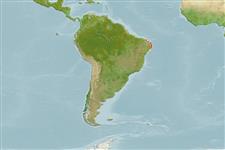>
Eupercaria/misc (Various families in series Eupercaria) >
Haemulidae (Grunts) > Haemulinae
Etymology: Haemulon: Greek, haimaleos = bloody (Ref. 45335).
Environment: milieu / climate zone / depth range / distribution range
Écologie
marin benthopélagique; profondeur 2 - 30 m (Ref. 37051). Tropical; 3°S - 10°S, 39°W - 34°W
Southwest Atlantic: Brazil, from off Fortaleza to the coast of Maceió.
Taille / Poids / Âge
Maturity: Lm ? range ? - ? cm
Max length : 19.5 cm TL mâle / non sexé; (Ref. 124459); poids max. publié: 110.90 g (Ref. 124459)
Épines dorsales (Total): 12; Rayons mous dorsaux (Total): 14-16; Épines anales 3; Rayons mous anaux: 8 - 9. Distinguished from all other species of Haemulon by the following combination of characters: a black blotch below the free edge of the preopercle; pectoral fins entirely scaled, except along edge; scale rows below lateral line parallel to long axis of body; lower half of head silvery-white, lacking stripes; fins yellow; body silvery-white with 10-12 yellow stripes, the midlateral the broadest.
Typically occurs in reefs, at depths of 2-30 m where it forms large schools during the day. Smaller schools, with less then 100 individuals, mostly juveniles, are seen on shallow reefs (2-6 m). At night the schools disperse to feed (Ref. 37051).
Life cycle and mating behavior
Maturité | Reproduction | Frai | Œufs | Fécondité | Larves
Oviparous, distinct pairing during breeding (Ref. 205).
Rocha, L.A. and I.L. Rosa, 1999. New species of Haemulon (Teleostei: Haemulidae) from the northeastern Brazilian coast. Copeia 1999(2):447-452. (Ref. 37051)
Statut dans la liste rouge de l'IUCN (Ref. 130435)
Menace pour l'homme
Harmless
Utilisations par l'homme
Plus d'informations
RéférencesAquacultureProfil d'aquacultureSouchesGénétiqueElectrophoresesHéritabilitéPathologiesTraitementNutrientsMass conversion
CollaborateursImagesStamps, Coins Misc.SonsCiguateraVitesseType de nageSurface branchialeOtolithesCerveauxVision
Outils
Articles particuliers
Télécharger en XML
Sources Internet
Estimates based on models
Preferred temperature (Ref.
123201): 27.3 - 27.5, mean 27.5 °C (based on 27 cells).
Phylogenetic diversity index (Ref.
82804): PD
50 = 0.5000 [Uniqueness, from 0.5 = low to 2.0 = high].
Bayesian length-weight: a=0.01259 (0.00749 - 0.02115), b=2.99 (2.85 - 3.13), in cm total length, based on LWR estimates for this species & Genus-body shape (Ref.
93245).
Niveau trophique (Ref.
69278): 3.4 ±0.3 se; based on size and trophs of closest relatives
Résilience (Ref.
120179): Haut, temps minimum de doublement de population inférieur à 15 mois (Preliminary K or Fecundity.).
Fishing Vulnerability (Ref.
59153): Low vulnerability (10 of 100).
